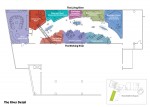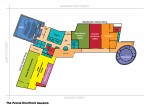Peoria Riverfront Museum’s “The Street” to Innovatively Capture the Region’s Colorful History
Peoria – The Peoria area’s history will surprise, educate and entertain you. Peoria Riverfront Museum collaborators proved that point today as they revealed details of The Street, a major, ever-changing gallery designed to bring to life the Peoria area’s long and colorful history—from its Native American roots through the initial French settlements to its place as the All-American bellwether of U.S. taste and beyond.
Collaborators playing a key role in planning The Street, including the Peoria Historical Society (PHS), Peoria Regional Museum Society (PRMS) and African American Hall of Fame Museum (AAHFM), spoke to supporters gathered at the Hotel Pere Marquette in downtown Peoria, a few blocks away from the seven-acre site of the proposed development.
State Sen. David Koehler, a long-time proponent of the museum block, said, “I’m excited to see the groundswell of support around The Block. I know this project will bring great educational, cultural, entertainment and economic opportunities to our region.” Koehler added he’s “looking forward to visiting The Street to explore more about the Peoria area’s early years and all the people and companies who have helped to make it what it is today.”
“We’ve talked previously about the features of the Riverfront Museum, including the IMAX Theatre and the planetarium,” said Museum Collaboration Group co-Chairperson Brad McMillan. “Today, we focus on the exhibit galleries planned for the Washington Wing of the museum, particularly The Street historical galleries showcasing the region’s history and the Oral History Center, where visitors of all ages can tell their stories for generations to come.”
The collaborators unveiled specific plans for The Street, including The Square, a nearly life-size streetscape integrating real objects from the region’s past, oversize graphics, text and interactive opportunities. The Square will feature an interpretive timeline of the area’s past, as well as fascinating stories unique to Peoria—some legendary, some little known. Anchoring The Square will be a massive video projection and large-scale artifacts supporting the current theme.
PHS Board President Marilyn Leyland said The Street will be a rotating exhibit with themed portions continually changing, starting with “Pride of Peoria: Innovation and Entrepreneurship.” Focusing on Peoria as a hardworking town, this inaugural theme will highlight the businesses and industries that brought wealth to the community and continue to flourish today, as well as showcase examples of that ingenuity—from bicycles and early automobiles to distilled spirits and earthmoving equipment, plus the advertising that promoted them.
A future theme of The Street is called “Will It Play in Peoria?” It will explore the importance of Peoria audiences, from riverboat and vaudeville patrons to coveted targets of modern market research. The region’s rich history provides an endless source of engaging themes and interesting stories to tell in the future.
“And on any given day, you might run into important people from the past,” said Leyland, introducing John Parks of the PRMS. Parks came in character as inventor Charles Duryea to announce the society would donate to The Street a Duryea automobile invented 110 years ago in a garage on West Barker Avenue, along with $40,000 for maintenance and exhibits explaining the vehicle’s history. “That gas-powered vehicle started people thinking in new ways,” Parks said. “It inspired Henry Ford—and we all know what happened next.”
Another important element of The Street will be an Oral History Center with a Story Booth to feature individual stories of Peoria-area residents. “Oral history has been an especially important tradition in the African-American community,” said Margie White, representing the AAHFM. “The Oral History Center will allow visitors to capture their own history, leaving with a DVD of their recording.” Selected recordings of general interest will be used by the museum in future exhibits.
The current African American Hall of Fame exhibit would be integrated into a Wall of Fame inside the Living History Center. This exhibit will honor individuals inducted into the Hall of Fame each year for having made an outstanding contribution to the Peoria African-American community.
In addition, the Caterpillar African American Network, an affinity group within Caterpillar that supports African-American employees, will donate $12,500 to the museum on behalf of AAHFM.
McMillan announced other Washington Wing exhibits will include an International Feature Gallery for special traveling exhibits—including the best exhibits the Smithsonian Institution has to offer—and traditional exhibits of fine art and folk art based on the extensive collections of Museum Collaboration Group partners. Announcements about exhibits to be included in the Liberty Wing of the museum will be made in the coming weeks, he added.
The multifaceted Riverfront Museum will join the Caterpillar Experience as key components of a planned downtown center for the arts, education and entertainment known as The Block. The $136 million project already has garnered $90 million in commitments to date, including 86 percent of the private funding and 40 percent of the public funding needed, said Michael Bryant, chairman of the CEO Roundtable, a group of prominent business leaders working to raise $8 million and the public awareness needed to help build the Riverfront Museum.
Tuesday, November 18, 2008, 1:00 p.m.










